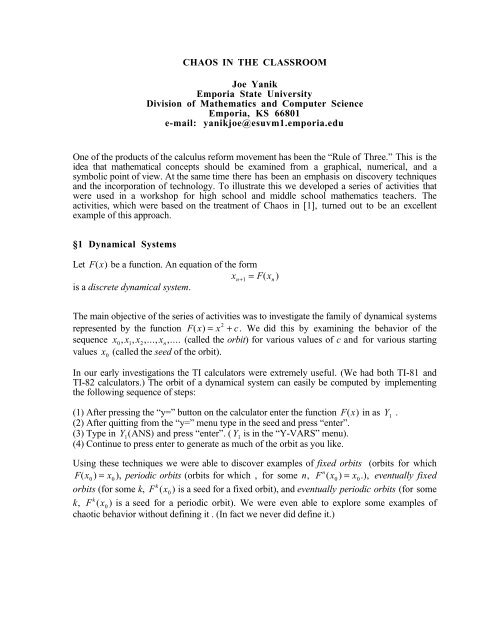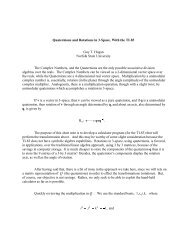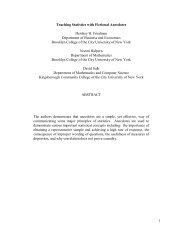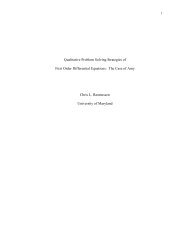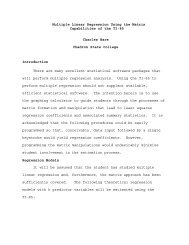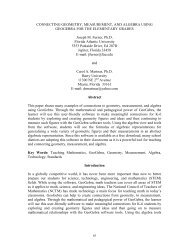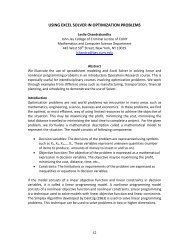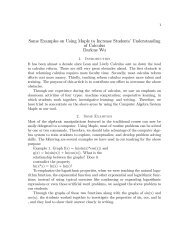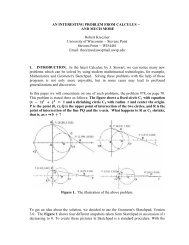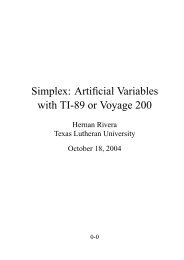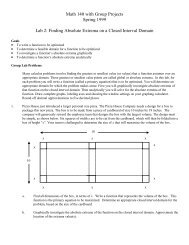Create successful ePaper yourself
Turn your PDF publications into a flip-book with our unique Google optimized e-Paper software.
CHAOS IN THE CLASSROOMJoe YanikEmporia State UniversityDivision of <strong>Mathematics</strong> and Computer ScienceEmporia, KS 66801e-mail: yanikjoe@esuvm1.emporia.eduOne of the products of the calculus reform movement has been the “Rule of Three.” This is theidea that mathematical concepts should be examined from a graphical, numerical, and asymbolic point of view. At the same time there has been an emphasis on discovery techniquesand the incorporation of technology. To illustrate this we developed a series of activities thatwere used in a workshop for high school and middle school mathematics teachers. Theactivities, which were based on the treatment of Chaos in [1], turned out to be an excellentexample of this approach.§1 Dynamical SystemsLet F(x) be a function. An equation of the formx n+1= F(x n)is a discrete dynamical system.The main objective of the series of activities was to investigate the family of dynamical systemsrepresented by the function F(x) = x 2 + c. We did this by examining the behavior of thesequence x 0, x 1, x 2,...,x n,.... (called the orbit) for various values of c and for various startingvalues x 0(called the seed of the orbit).In our early investigations the TI calculators were extremely useful. (We had both TI-81 andTI-82 calculators.) The orbit of a dynamical system can easily be computed by implementingthe following sequence of steps:(1) After pressing the “y=” button on the calculator enter the function F(x) in as Y 1.(2) After quitting from the “y=” menu type in the seed and press “enter”.(3) Type in Y 1(ANS) and press “enter”. ( Y 1is in the “Y-VARS” menu).(4) Continue to press enter to generate as much of the orbit as you like.Using these techniques we were able to discover examples of fixed orbits (orbits for whichF(x 0) = x 0), periodic orbits (orbits for which , for some n, F n (x 0) = x 0.), eventually fixedorbits (for some k, F k (x 0) is a seed for a fixed orbit), and eventually periodic orbits (for somek, F k (x 0) is a seed for a periodic orbit). We were even able to explore some examples ofchaotic behavior without defining it . (In fact we never did define it.)
§2 Graphical AnalysisAfter examining dynamical systems from the numerical point of view, we turned to thegraphical. One way of analyzing the behavior of a discrete dynamical system is throughgraphical analysis. To see how this works in practice follow the instructions below to analyzethe orbit of the dynamical system corresponding to F(x) = x 3 .1. On a coordinate system sketch a careful graph of y = x 3 along with a graph of the liney = x.2. We will begin with a seed of x 0=0.9. To find the orbit of x 0we begin at the point (x 0, x 0)on the line y = x. Draw a vertical line segment from there to the point ( x 0, x 1 ). You should nowbe on the curve y = x 3 .3. Continue by drawing a horizontal line segment back to the line y = x and you will be at thepoint ( x 1, x 1 ). Follow this with another vertical line segment to y = x 3 , then another horizontalto y = x . You should now be at (x 2, x 2). Continue in this way to locate (x k, x k)for k = 3,4,...until you can describe what is happening to the orbit.4. Use graphical analysis to characterize the orbit of every possible seed.By applying graphical analysis to a number of examples we were led to the conclusion that thefixed points, intersections of the graph of y = F(x) with the line y = x, were crucial to theunderstanding of the dynamical system. we also noticed that there were two importantcategories of fixed points, attracting fixed points (those that attract nearby orbits) and repellingfixed points (those that repel nearby orbits).One particularly illuminating investigation was the examination of the dynamical systemscorresponding to linear functions. Through graphical analysis the workshop participants wereable to completely characterize the behavior of linear systems. (When the absolute value of theslope is less than (respectively, greater than) one the fixed point is attracting (respectively,repelling).)§3 A Quadratic FamilyAt this point we began to concentrate our attention on the family of dynamical systems thatcorrespond to the function F(x) = x 2 + c for c a real number. The first step was to investigatethe fixed points of this system. This was the symbolic stage of the investigation as theparticipants were asked to derive the general formula for these fixed points. By using thequadratic formula they were able to determine that the fixed points were:p + = 1 (2 1 + 1 − 4c )andp − = 1 2 1 − 1 − 4c( )In particular there are no fixed points when c > 1 4 and exactly one fixed point when c = 1 4 .When c < 1 4there are exactly two fixed points. (This phenomenon, in which the system


